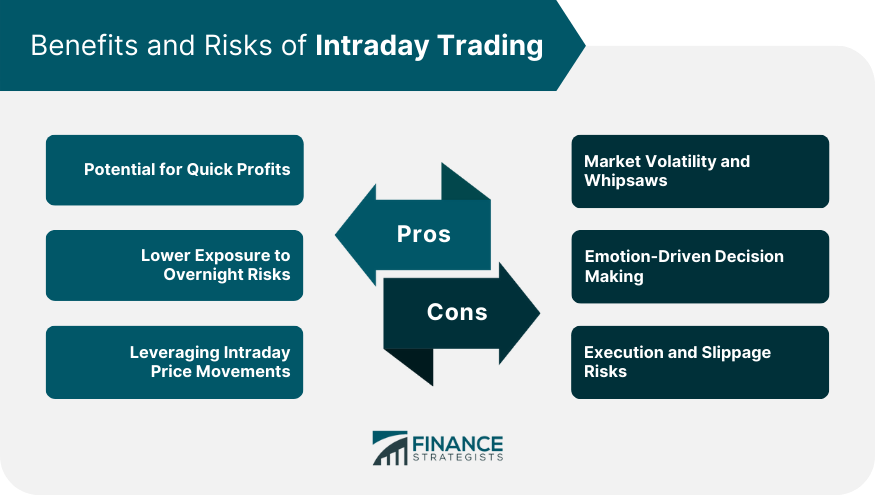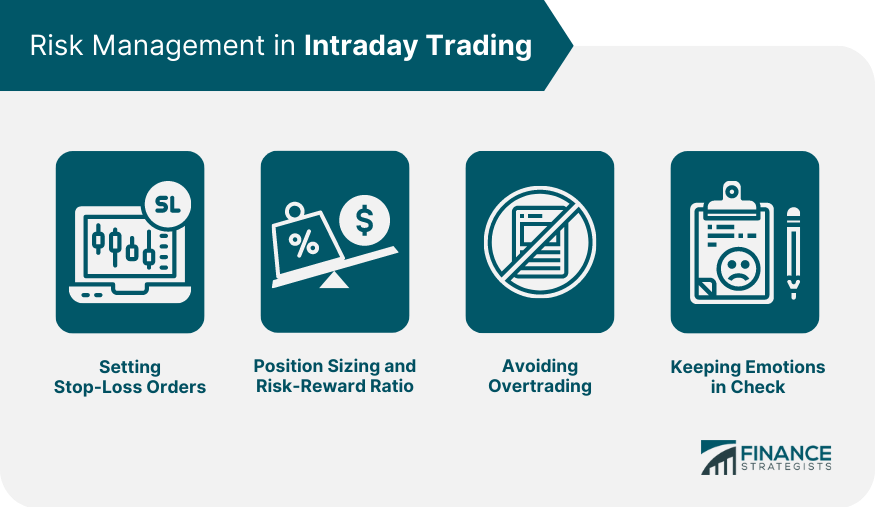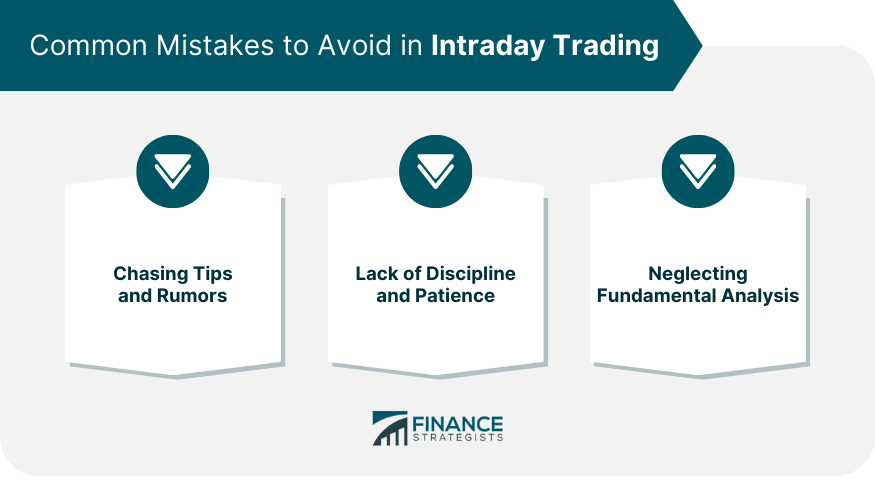Intraday trading, also known as day trading, is a trading style where all positions are opened and closed within the same trading day. This means that no position is left open overnight, and traders seek to profit from the price movements that occur within the day's trading hours. Intraday trading plays a pivotal role in financial markets. It contributes significantly to market liquidity and aids in efficient price discovery. Intraday traders absorb some of the market risk and play a crucial part in bridging the gap between short-term supply and demand in the market. Intraday trading operates within the confines of a single trading day. The duration of trading can vary across different markets, but typically ranges from a few minutes to several hours per trade, depending on the strategy used. Intraday trading is characterized by frequent transactions, high-volume trading, and small per-trade profits. Traders need to make quick decisions based on real-time data, which requires a high level of concentration and discipline. Volatility refers to the rate at which the price of an asset increases or decreases for a set of returns. Intraday traders profit from high volatility as it provides more opportunities for trading. Liquidity is the degree to which an asset can be quickly bought or sold without affecting its price. Intraday traders prefer highly liquid markets as they allow for quick entries and exits. The bid-ask spread is the difference between the highest price a buyer is willing to pay (bid) and the lowest price a seller is willing to accept (ask). A narrow spread is preferable for intraday traders, as it reduces transaction costs. Market depth refers to the market's ability to handle large orders without significant impact on price. It is represented by the bid-ask order book, which shows various price levels and the amount of volume available at each level. Given the frequent buying and selling of securities, intraday trading has the potential for quick profits. Traders can exploit small price movements throughout the day to generate returns. Since positions are not held overnight, intraday traders eliminate the risk of price gaps that can occur between the closing price of one day and the opening price of the next. Intraday traders can use leverage to multiply their buying power and potentially increase their profits. However, it's important to note that leverage can also amplify losses. While volatility can provide trading opportunities, it can also lead to significant losses. Whipsaw movements, where the price rapidly moves in different directions, can lead to frequent stop-loss triggers. The fast-paced nature of intraday trading can lead to decisions driven by fear or greed rather than rational analysis. This is often detrimental to trading performance. Rapid price movements can result in trade execution at prices different from the intended ones, a phenomenon known as slippage. This can affect the profitability of trades. Momentum trading involves buying and selling securities based on recent price trends. Traders using this strategy believe that these trends will continue in the short term. Breakout trading focuses on identifying key price levels that a security hasn't been able to move beyond, and then entering positions when the price breaks through these levels, expecting a significant price move. Reversal trading, or contrarian trading, involves identifying when the current price trend is likely to reverse. This strategy requires a high level of skill and experience. Scalping is a strategy where traders aim to profit from small price changes. It involves making dozens or hundreds of trades in a single day, each generating a small profit. Candlestick charts provide a visual representation of price movements over a specified period. They provide information about the open, high, low, and closing prices during the chosen period. Moving averages smooth out price data to identify trends over a specific period. They can be used to generate trading signals when the price crosses the moving average. The RSI is a momentum oscillator that measures the speed and change of price movements. It can be used to identify overbought and oversold conditions in the market. Volume analysis involves examining the number of shares or contracts traded in a security or market. It can provide insights into the strength or weakness of a price trend. Stop-loss orders are designed to limit an investor's loss on a position. By predefining the exit point for a losing trade, traders can prevent large losses. Position sizing refers to the amount of capital invested in a particular trade. The risk-reward ratio, on the other hand, compares the potential profit of a trade to the potential loss. Both are crucial elements of a risk management strategy. Overtrading, the act of trading excessively, can lead to high transaction costs and increased risk. It often results from a lack of a trading plan or discipline. Trading decisions should be based on rational analysis rather than emotions. Techniques such as meditation, breathing exercises, and setting realistic expectations can help manage trading-related stress. Online brokerage platforms provide the interface for placing trades. They offer a range of tools for market analysis, order execution, and risk management. DMA allows traders to place trades directly with the exchange, bypassing the broker. This can result in faster execution speeds and lower costs. Algorithmic trading involves using computer programs to place trades based on predefined criteria. It can increase trading speed and accuracy, and minimize emotional interference. Trading based on tips and rumors can lead to poor decisions. It's essential to perform independent analysis and make informed trading decisions. Successful intraday trading requires discipline to follow the trading plan and patience to wait for the right trading opportunities. While intraday trading is largely based on technical analysis, ignoring fundamental analysis can be a mistake. Economic events, news releases, and earnings reports can all have significant impacts on price movements. Intraday trading is a style where all positions are opened and closed within the same trading day. It involves capitalizing on short-term price movements to generate profits. It offers benefits such as the potential for quick profits, lower exposure to overnight risks, and leveraging intraday price movements. However, it also comes with risks and challenges, including market volatility, emotion-driven decision making, and execution risks. Traders can employ various strategies like momentum trading, breakout trading, reversal trading, and scalping, while utilizing tools and indicators such as candlestick charts, moving averages, RSI, and volume analysis. Effective risk management, utilizing technology and platforms, and avoiding common mistakes are essential in successful intraday trading. It is crucial to acknowledge that intraday trading can be complex and requires a deep understanding of the market dynamics. Therefore, seeking professional guidance from experienced traders or financial advisors is strongly advised. Professionals can offer valuable insights and assist in understanding the nuances of intraday trading to help navigate the challenges associated with this trading style. Professional advice can significantly enhance your trading performance and improve your overall outcomes.What Is Intraday Trading?
Key Concepts in Intraday Trading
Volatility
Liquidity
Bid-Ask Spread
Market Depth
Benefits of Intraday Trading
Potential for Quick Profits
Lower Exposure to Overnight Risks
Leveraging Intraday Price Movements
Risks and Challenges in Intraday Trading
Market Volatility and Whipsaws
Emotion-Driven Decision Making
Execution and Slippage Risks

Intraday Trading Strategies
Momentum Trading
Breakout Trading
Reversal Trading
Scalping
Tools and Indicators for Intraday Trading
Candlestick Charts
Moving Averages
Relative Strength Index (RSI)
Volume Analysis
Risk Management in Intraday Trading
Setting Stop-Loss Orders
Position Sizing and Risk-Reward Ratio
Avoiding Overtrading
Keeping Emotions in Check

Technology and Platforms for Intraday Trading
Online Brokerage Platforms
Direct Market Access (DMA)
Algorithmic Trading
Common Mistakes to Avoid in Intraday Trading
Chasing Tips and Rumors
Lack of Discipline and Patience
Neglecting Fundamental Analysis

Final Thoughts
Intraday Trading FAQs
The minimum capital required for intraday trading can vary depending on factors such as the trading platform, regulatory requirements, and individual risk tolerance. However, it is generally recommended to have a sufficient amount of capital to accommodate the potential losses and meet the margin requirements set by the broker.
Yes, intraday trading allows you to trade multiple stocks within a single day. Traders often monitor several stocks simultaneously, looking for opportunities that meet their trading strategies. However, it's essential to manage your trades effectively and avoid overtrading, which can increase transaction costs and risk.
While prior trading experience can be beneficial, it is not a strict requirement for engaging in intraday trading. However, it is crucial to have a solid understanding of basic trading concepts, technical analysis tools, risk management strategies, and market dynamics. Learning through educational resources and practicing with virtual trading platforms can help develop the necessary skills.
Intraday trading can be challenging for part-time traders with limited time availability. The fast-paced nature of day trading requires constant monitoring of the market and quick decision-making. However, part-time traders can still participate by focusing on specific timeframes or employing trading strategies that require less active management, such as swing trading.
To minimize risks in intraday trading, it is important to implement effective risk management strategies. This includes setting stop-loss orders to limit potential losses, sizing positions appropriately based on risk-reward ratios, avoiding overtrading, and keeping emotions in check. Additionally, staying informed about market news and developments can help anticipate potential price movements and mitigate risks.
True Tamplin is a published author, public speaker, CEO of UpDigital, and founder of Finance Strategists.
True is a Certified Educator in Personal Finance (CEPF®), author of The Handy Financial Ratios Guide, a member of the Society for Advancing Business Editing and Writing, contributes to his financial education site, Finance Strategists, and has spoken to various financial communities such as the CFA Institute, as well as university students like his Alma mater, Biola University, where he received a bachelor of science in business and data analytics.
To learn more about True, visit his personal website or view his author profiles on Amazon, Nasdaq and Forbes.











